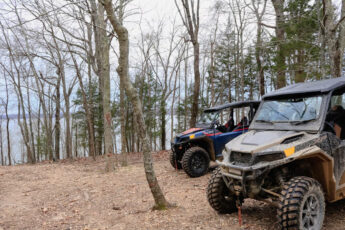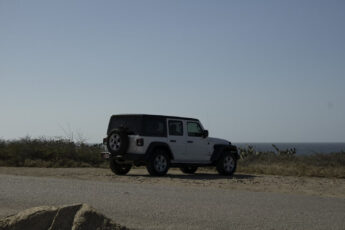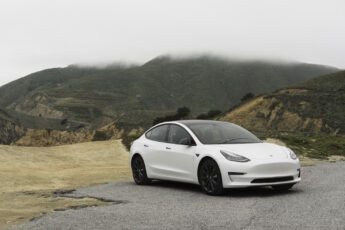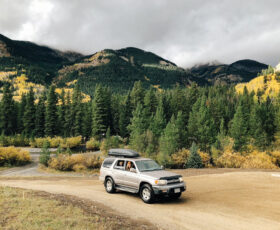Last Updated on 4 months
Discovering the Best Winter Tires for Enhanced Winter Driving
The Michelin X-Ice Snow SUV is the perfect choice if you’re looking for reliable performance in various winter conditions. Continuously impressing users with its lower rolling resistance, better ice braking, and resistance to hydroplaning, these tires are a successor to the X-Ice Xi3. In addition, they maintain excellent traction and stability, especially in SUVs. The Michelin X-Ice Snow SUV strikes the ideal balance between safety and driving pleasure during winter, making it a perfect choice for drivers navigating snowy roads.
Key Takeaways
- Michelin X-Ice Snow SUV offers exceptional winter traction and stability for various models.
- Successor to the X-Ice Xi3, this tire promises lower rolling resistance, better ice braking, and resistance to hydroplaning.
- It is designed to feel normal in dry conditions, making it an excellent choice for those seeking assurance and driving pleasure during winter.
- Durability is a key selling point, with one additional winter of usage over competitors.
- It’s a popular choice among customers and is top-rated by retailers such as Tire Rack and Amazon.
Introduction to Choosing the Right Winter Tires
Winter tires, also called snow tires, are engineered for optimal performance in harsh winter conditions, offering superior traction and safety on snow-covered and icy roads. They are designed with specialized tread patterns and compounds that remain flexible in low temperatures. Choosing the correct set of winter tires is critical for drivers to ensure safety and vehicle performance in winter conditions.
There are various factors to consider when selecting the most suitable winter tires for your vehicle. These factors include your driving habits, vehicle specifications, and the severity of the winter conditions you expect to encounter. This section will discuss essential aspects to evaluate while choosing the perfect winter tires.
- Tire performance classifications: Winter tires are generally classified into three categories based on their performance and capabilities: performance, studdable, and studless. Performance winter tires are designed for optimal handling in dry conditions, whereas studdable and studless tires focus on providing grip on ice and deep snow.
- Compatibility with your vehicle: It is crucial to ensure that the selected winter tires match your vehicle’s specifications, such as size, load-carrying capacity, and speed ratings. Refer to your vehicle’s owner’s manual for proper tire specifications.
- Tread patterns and compounds: The tread pattern and rubber compound play a significant role in determining the performance of winter tires. Look for tires with a high-density sipe design and advanced rubber compounds that remain flexible in low temperatures for better traction and handling on icy roads.
- Price and value: When browsing winter tires, consider your budget and the potential long-term value a specific tire can offer. It is essential to balance affordability with performance, ensuring you do not compromise on safety and quality.
Additionally, it is beneficial to research and compare different winter tire options available in the market. Below, we present a table featuring some of the top winter tires and their respective features:
| Tire Model | Performance Class | Special Features |
|---|---|---|
| Michelin X-Ice Snow SUV | Studless | Excellent winter traction, designed for SUVs and light trucks |
| Nokian Hakkapeliitta R5 | Studdable | Aggressive tread pattern, superior performance in deep snow |
| Bridgestone Blizzak WS90 | Studless | Improved tread design and longer tread life |
| Continental VikingContact 7 | Studless | Environmentally friendly, canola oil-infused rubber compound |
By considering the abovementioned factors and comparing various winter tire options, you can choose the correct set of winter tires for your vehicle. This will ensure a safer and more enjoyable driving experience during the colder months.
Michelin X-Ice Snow SUV: Stability and Traction for Your SUV
The Michelin X-Ice Snow SUV distinguishes itself with superior wintertime traction and stability suitable for various SUV models. The tire’s specialized tread design and rubber compound consistently grip snow and ice. Its enhanced features offer drivers confident handling and safety in diverse icy conditions.
What Sets Michelin X-Ice Snow SUV Apart
The X-Ice Snow SUV integrates unique features that enhance its winter performance. Key innovations that set the Michelin X-Ice Snow SUV apart include:
- Flex-Ice silica-based rubber compound maintains flexibility in freezing temperatures, improving snow and ice grip.
- Micro-Pumps and EverGrip Technology: These features efficiently remove thin water films from the contact patch, enhancing grip on ice.
- Directional Tread Design with Independent Shoulder Blocks: The tread pattern increases traction on snow, slush, and ice, while the shoulder blocks significantly contribute to lateral grip.
Customer Satisfaction and Performance Reviews
Michelin’s X-Ice Snow SUV has garnered positive reviews from customers who commend its deep-snow traction and performance. While studies have noted increased noise levels compared to some competitors, the tire’s overall winter capabilities and improved handling in dry conditions have proved satisfactory. Additionally, the Michelin X-Ice Snow for light trucks is recommended for SUVs, and light trucks are reported to perform admirably in dry and slushy environments.
“The X-Ice Snow SUV provided excellent traction in deep snow, making me feel confident about my family’s safety during a harsh winter storm. While there is slightly more noise than our previous tires, the performance outweighs this minor inconvenience.”
In conclusion, the Michelin X-Ice Snow SUV stands out as a high-performing, reliable winter tire for SUVs, earning praise for its exceptional traction and control in various winter conditions. Featuring innovative technology and design elements, the X-Ice Snow SUV is a top choice for those seeking a safe and enjoyable winter driving experience.
Nokian Hakkapeliitta R5: Uncompromising Grip for Cars
The Nokian Hakkapeliitta R5 is a top-tier winter tire renowned for its exceptional performance, particularly in cars. With an aggressive tread pattern and silica compound, this tire excels in deep snow and icy conditions, providing solid performance and making it the optimal winter driving experience.
While the Hakkapeliitta R5 carries a premium price, its quality and safety characteristics make it a valuable investment. Without compromising performance in challenging winter conditions, the Finnish manufacturer Nokian once again exemplifies its expertise in the winter tire market since 1932.
“The Nokian Hakkapeliitta R5 offers exceptional grip and handling, even in the most extreme winter situations. Its aggressive tread pattern and innovative silica compound work together to ensure solid performance and safety on icy, snowy roads.”
Let’s take a closer look at some of the Hakkapeliitta R5’s standout features:
- Aggressive tread pattern for enhanced traction and safety on snow and ice.
- Silica compound designed for improved flexibility and grip in low temperatures.
- Pioneering legacy by a Finnish manufacturer with an enduring commitment to winter tire innovation.
- Zero-compromise winter driving experience, offering both superior safety and performance capabilities.
As we examine the benefits and characteristics of the Nokian Hakkapeliitta R5, it’s easy to see why this tire is a top choice for those seeking safety and dependability during the winter months. Even in extreme conditions, ensure a confident driving experience by choosing the Hakkapeliitta R5 for your winter tire needs.
Bridgestone Blizzak WS90: The Evolution of Snow Tires for Cars
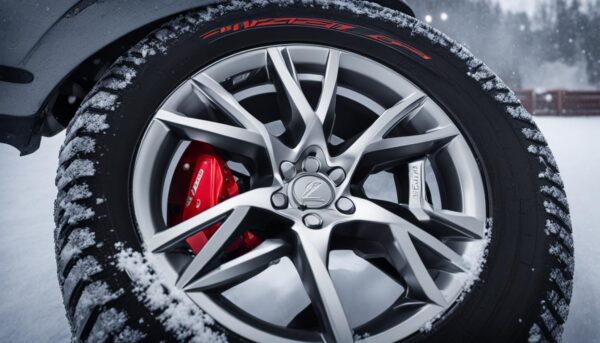
The Bridgestone Blizzak WS90 is a significant step forward in the evolution of snow tires for cars, as it brings numerous improvements compared to its predecessors, most notably the WS80 model. In this section, we’ll delve into the advancements the Blizzak WS90 offers and explore why it has become a leader in deep snow traction among snow tires for cars.
Improvements Over Previous Generations
Some of the primary enhancements of the Bridgestone Blizzak WS90 over previous generations include an updated tread design, compound enhancements for longer tread life, and a more comprehensive range of sizes. Major retailers like Amazon and Walmart have highlighted these updated features, signifying the WS90’s superior capability in snow compared to its predecessors.
| Feature | WS80 | WS90 |
|---|---|---|
| Tread Design | Optimized for light to moderate snow | Updated design for versatile snow performance |
| Tread Compound | Standard winter compound | Enhanced compound for longer life |
| Size Range | Limited sizes | Wider range to fit more vehicles |
Why Bridgestone Blizzak WS90 Leads in Deep Snow Traction
The Bridgestone Blizzak WS90 is acclaimed for its exceptional performance in deep snow conditions. The tire’s improved design elements result in a remarkable combination of traction and handling that inspires driver confidence in challenging winter environments. The following quote from a satisfied customer echoes its prowess:
“I have driven on other winter tires before, but the Blizzak WS90 stands out for its incredible performance in deep snow. I feel much more confident on the road.”
Long-term use of the Blizzak WS90 has further validated its superiority in deep snow, with many customers reporting solid traction, handling, and overall satisfaction. Suppose you’re seeking a reliable, high-performing snow tire for your car. In that case, the Bridgestone Blizzak WS90 makes an excellent choice, offering industry-leading traction in deep snow conditions and an overall safer driving experience.
Continental VikingContact 7: The Environmentally Friendly Winter Tire Option
Continental’s VikingContact 7 has gained a solid reputation as an environmentally friendly winter tire option. Its unique rubber compound includes canola oil, aiding flexibility under extreme cold conditions. The tire’s tread pattern is designed to feature numerous edges, allowing maximum snow traction.
By implementing green manufacturing processes and championing sustainable materials, Continental has set VikingContact 7 apart as an ideal choice for environmentally conscious drivers. Let’s take a closer look at the key features and performance of the VikingContact 7:
“Continental’s VikingContact 7 is lauded for being an environmentally friendly winter tire option, featuring a rubber compound that includes canola oil for flexibility in extreme cold.”
- Ecologically friendly rubber compound with canola oil.
- Tread pattern designed for maximum snow traction.
- Green manufacturing processes.
- Impressive winter weather performance.
These features have earned the VikingContact 7 a top choice status for drivers who prioritize environmentally responsible options without sacrificing performance in snowy conditions. The tire has been tested for various winter conditions, and results indicate that it can hold its own against the implementation of mainstream winter tires.
| Tire | Environmentally Friendly | Snow Traction |
|---|---|---|
| Continental VikingContact 7 | Yes | Excellent |
| Michelin X-Ice Snow SUV | No | Excellent |
| Bridgestone Blizzak WS90 | No | Excellent |
In conclusion, the Continental VikingContact 7 is a commendable winter tire for those seeking an environmentally friendly option without compromising performance. Its unique rubber compound and tread design ensure drivers can safely navigate snowy conditions while minimizing environmental impact.
Cooper Discoverer True North: Versatility Across Winter Conditions
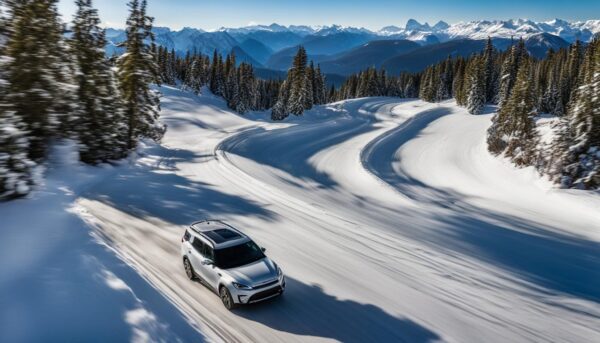
The Cooper Discoverer True North sets itself apart with its unique blend of features designed to perform optimally in various winter conditions. The highest silica content among Cooper’s winter tire lineup provides adequate grip on icy surfaces, ensuring reliable traction and stability on slippery roads.
What makes this tire stand out is its origin. Engineers discovered the benefits of the high silica content while rigorously testing the tires on the snowy inclines of California’s Donner Pass. This testing environment further showcases the tire’s impressive proficiency in handling a wide array of wintery conditions, from snow-caked roads to icy paths.
The Science Behind the High Silica Content
High silica content in winter tires enhances their ability to grip slippery surfaces effectively.
But how does this high silica content make a difference? Silica, when added to the rubber compound of a tire, is known to improve traction on wet and icy surfaces by increasing the tire’s flexibility at lower temperatures. The increased flexibility allows the rubber to better conform to the road’s character, which leads to more excellent grip and control for the driver. While this science doesn’t guarantee tire performance under all conditions, it significantly contributes to the Cooper Discoverer True North’s versatility and performance.
Overall, the Cooper Discoverer True North is a strong contender in the winter tire market, offering drivers an impressive combination of grip, control, and adaptability in diverse winter conditions. If you require a tire that can confidently handle varying winter conditions, the Cooper Discoverer True North may be the perfect choice for your vehicle.
Pirelli P Zero Winter: Where Performance Meets Winter Resilience
The Pirelli P Zero Winter is an ideal tire option for drivers who prioritize retaining optimal handling in dry conditions while delivering enhanced winter performance. This tire is designed for driving enthusiasts and offers a well-rounded balance of performance and winter readiness for a more enjoyable driving experience.
In previous tests, the P Zero Winter’s grip on a Porsche 911 was close to that of factory summer tires, demonstrating its ability to deliver exceptional performance in dry and cold weather conditions. This versatility makes the Pirelli P Zero Winter a highly sought-after choice for those occasionally encountering snow and ice on the roads.
| Tire Model | Performance in Snow and Ice | Performance in Dry Conditions |
|---|---|---|
| Pirelli P Zero Winter | Enhanced winter readiness | Optimal handling and grip |
| Factory Summer Tire | Limited traction and performance | Exceptional handling and grip |
In summary, the Pirelli P Zero Winter tire caters to driving enthusiasts who demand both high-performance characteristics in their tires and uncompromising winter resilience. By balancing these aspects, the Pirelli P Zero Winter ensures a safe and enjoyable driving experience across various conditions.
Dunlop Winter Maxx: Quality Winter Tires for SUVs on a Budget
As winter approaches, finding a set of reliable and budget-friendly winter tires for your SUV is essential for maintaining safety and performance. One such option is the Dunlop Winter Maxx, which has gained recognition for its affordability without compromising quality.
Analyzing Dunlop Winter Maxx’s Competitive Edge
The Dunlop Winter Maxx is famous for SUV owners seeking a budget-friendly winter tire solution. Retailer Walmart showcases these tires at a 26% discount, making them highly accessible to many consumers. Despite their affordability, the Dunlop Winter Maxx provides several key features that make it a standout choice for winter driving:
- Asymmetric Tread Patterns: This unique design helps to enhance traction on snow and ice while providing a quieter ride.
- Impressive Braking Capabilities: In previous tests, the Dunlop Winter Maxx has demonstrated braking performance that nearly matches the top winter tires in the market.
- Exceptional Value for Money: The Dunlop Winter Maxx is an excellent option for those seeking a cost-effective set of winter tires without compromising safety and performance.
“The Dunlop Winter Maxx is a fantastic choice for budget-conscious drivers seeking reliable winter tires for their SUV. The quality of these tires, despite their more affordable price tag, is impressive and provides excellent value for the money.”
– A satisfied customer
In conclusion, the Dunlop Winter Maxx is a prime example of a budget-friendly winter tire that doesn’t skimp on performance or safety. SUV owners can enjoy the peace of mind that comes with having a reliable set of winter tires to navigate through snow, ice, and challenging road conditions while staying within budget constraints.
How All-Season Tires Compare in Snowy Conditions
All-season tires have become popular due to their versatility and ability to balance summer and winter tire performance. However, when it comes to snowy conditions, they may not provide the traction and stability necessary for optimal driving safety.
All-season tires generally offer adequate traction for light to moderate snow and winter storms. While popular and versatile, their performance in winter scenarios does not equate to that of dedicated winter/snow tires. They often underperform on dry or wet roads in warm temperatures compared to summer or winter-specific tires, indicating a clear performance distinction in deep snow or packed ice conditions.
To further illustrate the differences between all-season and winter tires, consider the following comparison:
| Tire Type | Traction in Snow | Icy Road Performance | Handling in Wet Conditions |
|---|---|---|---|
| All-Season Tires | Adequate for light to moderate snow | Mediocre, especially on packed ice | Good in warm temperatures, reduced performance in colder weather |
| Winter/Snow Tires | Optimal traction in deep snow and various winter conditions | Superb grip and stability on icy roads | Excellent handling and stopping power in cold, wet conditions |
As the table above shows, all-season tires may not provide the necessary grip and stability that dedicated winter tires can offer on snowy and icy roads. While famous for their versatility and cost-effectiveness, all-season tires may not be the safest option in harsh winter conditions.
If you frequently face heavy snowfall and icy roads during winter, investing in a set of dedicated winter tires is the best option for ensuring a safe and reliable driving experience.
In conclusion, while all-season tires can be convenient and cost-effective for drivers who encounter mild winter conditions, they may not offer the superior traction and control needed in more severe, snowy, and icy environments. For those who prioritize safety and optimal performance under harsh winter conditions, dedicated winter/snow tires are the preferred choice.
Winter Tire Maintenance and Care Tips
Proper maintenance and care of winter tires are crucial for optimizing their life span and performance. It includes maintaining correct tire inflation, regular rotation to promote even wear, and proper storage away from direct sunlight and heat sources. Experts recommend using a complete set of winter tires instead of mixing with all-season or summer tires to avoid handling inconsistencies and reduce stopping power on snow and ice.
Maximizing Tire Life Through Proper Storage and Use
It is essential to follow specific guidelines to make sure your winter tires are always at their best performance:
- Check tire inflation regularly to ensure optimal tire pressure is maintained. Incorrect tire pressure can lead to uneven wear and potentially reduced grip on icy roads.
- Rotate your tires every 6,000 miles, or as your vehicle manufacturer recommends, to prevent uneven wear patterns and increased tread wear.
- Store your winter tires in a cool, dry place when not in use. This helps to prevent the rubber compound from drying out and cracking, ensuring a longer life span.
- Replace your tires on time when they reach their wear limit. Worn-out tread patterns will significantly affect your vehicle’s traction on slippery winter roads.
Remember, experts recommend using a complete matching set of winter tires instead of mixing them with all-season or summer tires. Mixing tire types can lead to handling inconsistencies and reduced overall performance.
| Maintenance Tip | Brief Explanation |
|---|---|
| Regular tire inflation checks | Achieve optimal pressure and maintain grip on icy roads |
| Rotate tires every 6,000 miles | Balanced wear patterns and increased tread life |
| Cool, dry storage | Prevent rubber degradation and ensure longevity |
| Timely replacements | Optimal traction and safety in winter conditions |
By following these simple guidelines, you can ensure that your winter tires continue to provide maximum traction and safety in challenging winter conditions for several seasons.
Wrapping Up Your Winter Tire Selection
Ultimately, finding the perfect winter tires for your vehicle depends on your specific car model, the typical driving conditions, and preferences. High-performing options like the Michelin X-Ice Snow SUV, Nokian Hakkapeliitta R5, and Bridgestone Blizzak WS90 offer superior traction and safety features, giving you peace of mind and a secure driving experience during the colder months.
Remember, it is not solely about choosing a highly-rated tire but finding one that aligns with your unique needs and priorities. Features such as budget, environmental concerns, and the desire for enhanced dry-road handling can all impact your final decision. Always opt for real-world testing and customer reviews to maximize your confidence in your winter tire selection.
By investing in a reliable set of winter tires, you can ensure your safety and vehicle performance in the harshest weather conditions. Proper maintenance and care are vital to prolong the life of your tires, and ultimately, choosing well-aligned winter tires will result in a secure and enjoyable driving experience all season long.
FAQ
What factors should I consider when choosing winter tires?
When selecting winter tires, consider vehicle type, driving conditions, and personal preferences. Research various winter tire brands and reviews to find the best match for your needs.
How do winter tires differ from all-season tires in snowy conditions?
Winter tires are designed for optimal performance in snow, ice, and cold temperatures. They have specialized tread patterns and compounds that remain flexible in low temperatures, providing better traction and safety. All-season tires offer adequate traction for light to moderate snow but underperform compared to dedicated winter tires in severe conditions.
Can I mix winter tires with all-season or summer tires on my vehicle?
No, mixing different types of tires on your vehicle is not recommended. A complete set of winter tires is advised, as mixing with all-season or summer tires can lead to handling inconsistencies and reduced stopping power on snowy and icy roads.
How do I maintain and care for my winter tires?
Proper maintenance of winter tires includes maintaining correct tire inflation, regular rotation to promote even wear, and proper storage away from direct sunlight and heat sources. These practices help optimize the life span and performance of your tires.
What are some top-rated winter tire brands and models?
Some highly-regarded winter tire options include Michelin X-Ice Snow SUV, Nokian Hakkapeliitta R5, Bridgestone Blizzak WS90, Continental VikingContact 7, Cooper Discoverer True North, Pirelli P Zero Winter, and Dunlop Winter Maxx. Each tire offers specific benefits and features, so research their performance and read reviews before deciding.
Source Links
The Best Winter And Snow Tires You Can Buy




